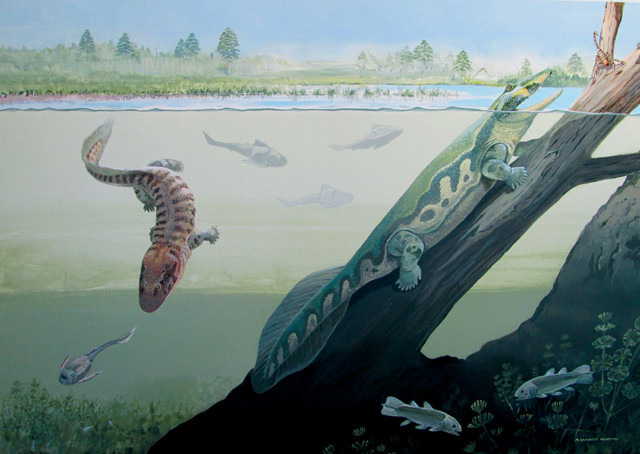
by Lucas Joel Monday, September 10, 2018

This illustration depicts ancient Antarctic tetrapods in their aquatic habitats. Tutusius is to the right; Umzantsia is to the left. Credit: Maggie Newman.
Tetrapods include all those animals with four limbs. Humans are tetrapods, as are dogs and dinosaurs and salamanders. The earliest tetrapods evolved on land from fish with bony fins during the Devonian Period between about 420 million and 359 million years ago. Until now, fossils of the earliest four-legged forms were only known from equatorial regions, but paleontologists working in South Africa now report the discovery of fossil tetrapods that lived in the Late Devonian Antarctic.
Robert Gess, a paleontologist at Rhodes University in Grahamstown, South Africa, made the finds near Grahamstown at a fossil-rich site known as the Waterloo Farm lagerstätte. There, he unearthed two new species — Tutusius umlambo and Umzantsia amazana — in rocks that were a part of the ancient supercontinent Gondwana. Before the discovery, there were only 12 known tetrapod species from the Devonian. Because those species all originated from tropical regions, researchers believed that the early evolution of tetrapods probably happened in the tropics as well.
“Discovery of two new species of tetrapods … within the Gondwanan Antarctic Circle completely disrupts this belief,” says Gess, who, alongside Per Ahlberg, a paleontologist at Uppsala University in Sweden, announced the discoveries in a study in Science. One of the new species, U. amazana, is the most primitive of all known tetrapods. “Terrestrialization of vertebrates could … therefore have occurred at any latitude,” he says.
© 2008-2021. All rights reserved. Any copying, redistribution or retransmission of any of the contents of this service without the expressed written permission of the American Geosciences Institute is expressly prohibited. Click here for all copyright requests.